Abstract
Newborn, male, Holstein calves, were continuously housed for three weeks in calf hutches at 17 degrees C or in a thermal environment which varied rhythmically on a daily basis either between -20 degrees C and -8 degrees C (experiment A) or between -30 degrees C and -18 degrees C (experiment B). Compared to warm-housed calves, cold-housed calves in experiment A had metabolic rates which were significantly higher (p less than 0.001) in a standing position but which were not significantly different (p less than 0.05) in a recumbent position. Recumbent and standing cold-housed calves in experiment B had an increased (p less than 0.05) metabolic rate compared to warm-housed controls. Heat loss was less (p less than 0.05) for recumbent cold-housed calves in experiment B than for standing calves in a thermoneutral environment. Localized subcutaneous hemorrhages of hindlimbs were a consistent necropsy finding among all cold-housed calves. Average daily gains of cold-housed calves were not significantly different from warm-housed controls. Clinical, physiological and pathological findings indicated that cold treatments used in the present study did not cause serious harm to calves. It was concluded that calves housed in properly managed hutches are remarkably cold tolerant.
Full text
PDF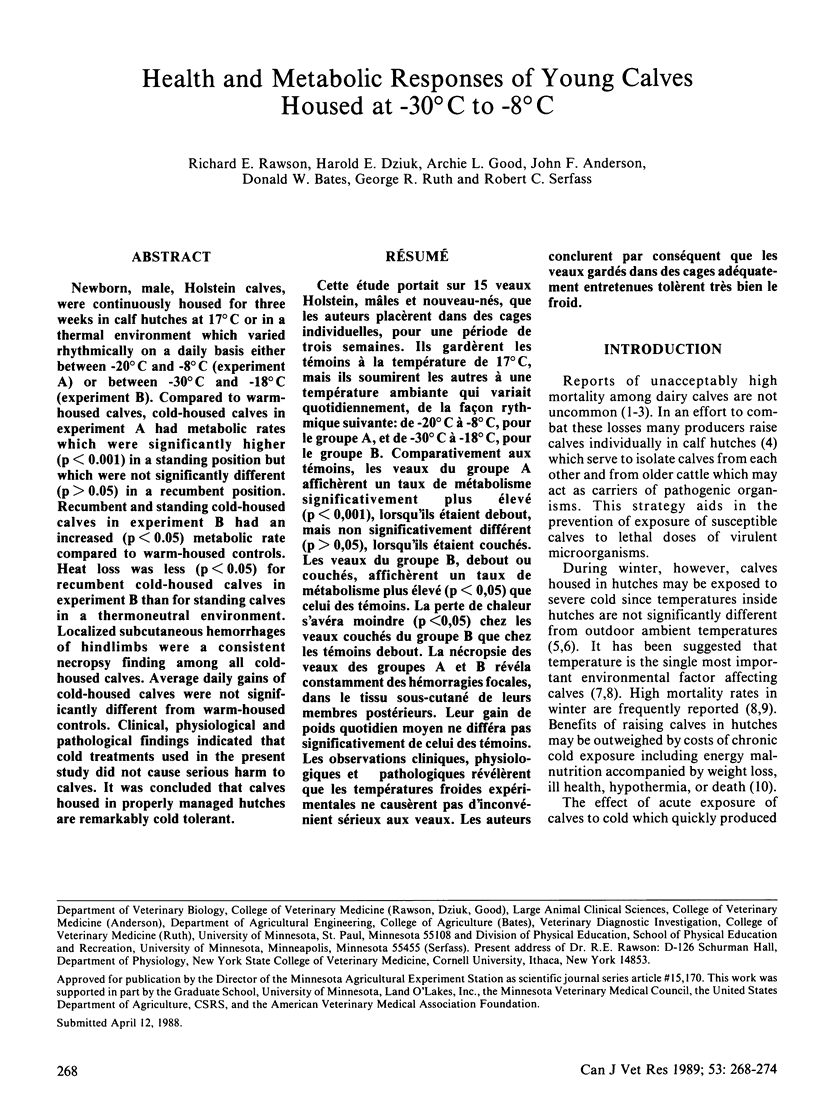

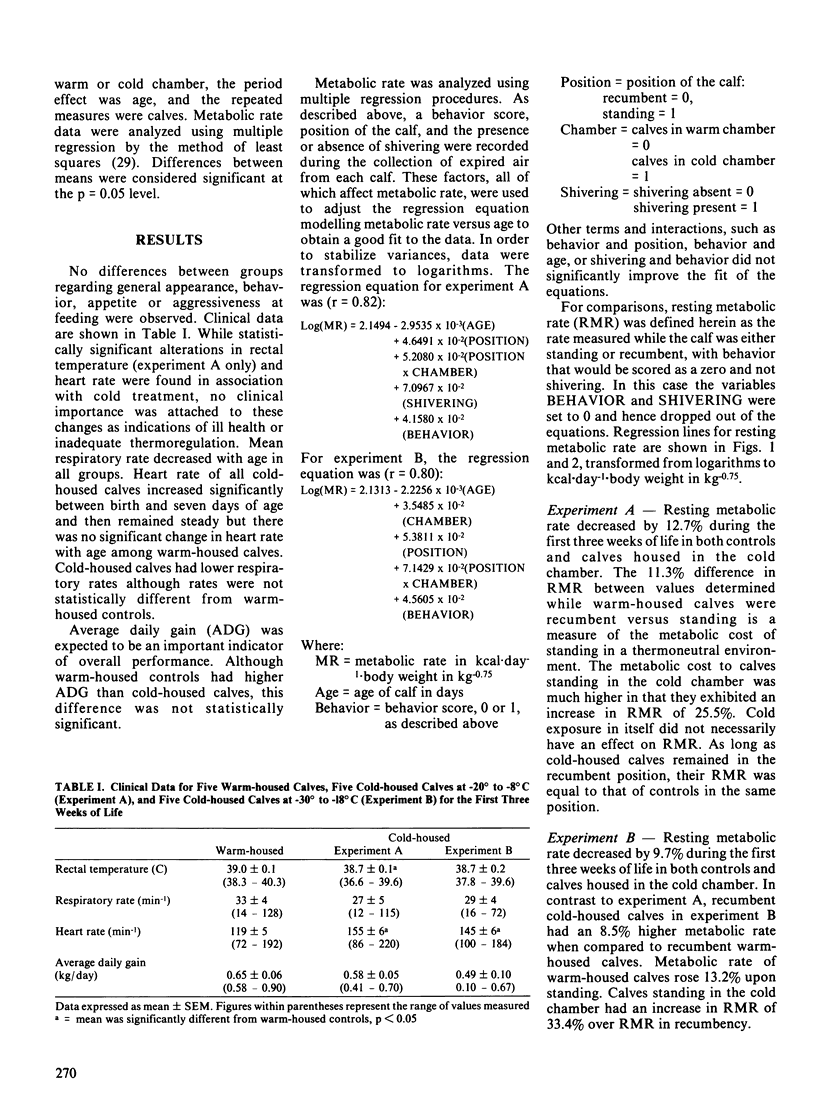
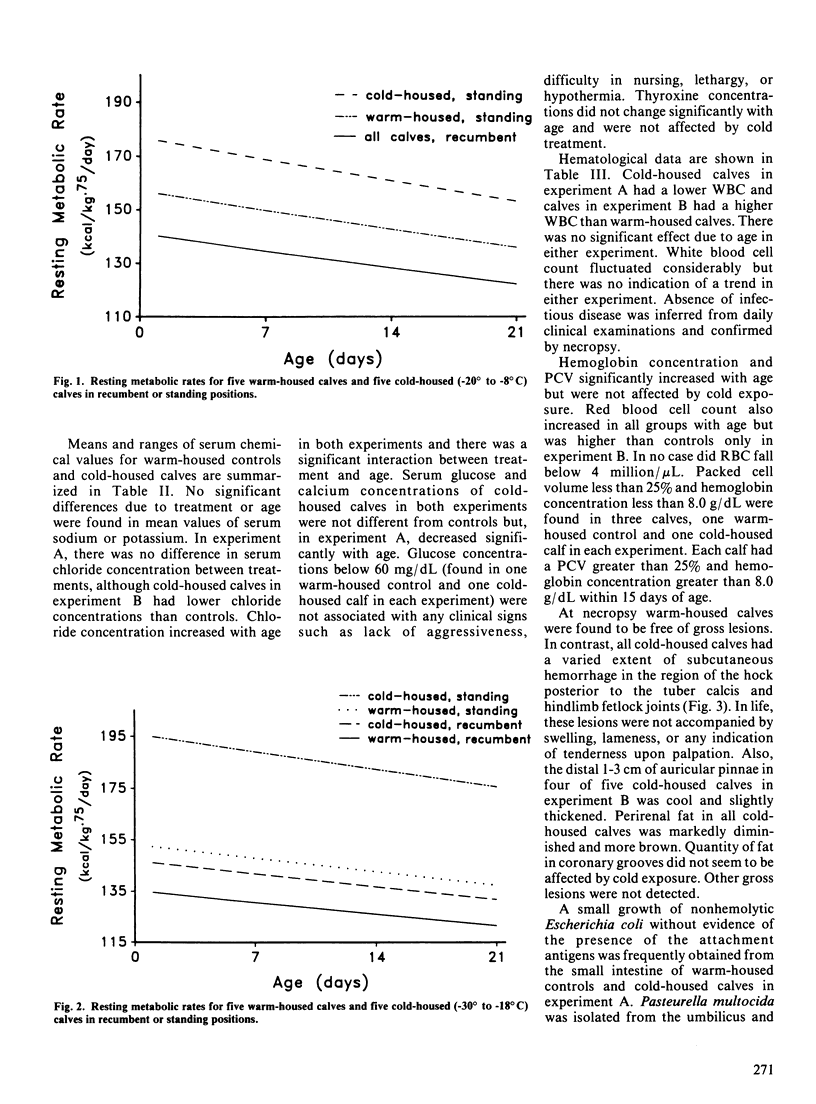
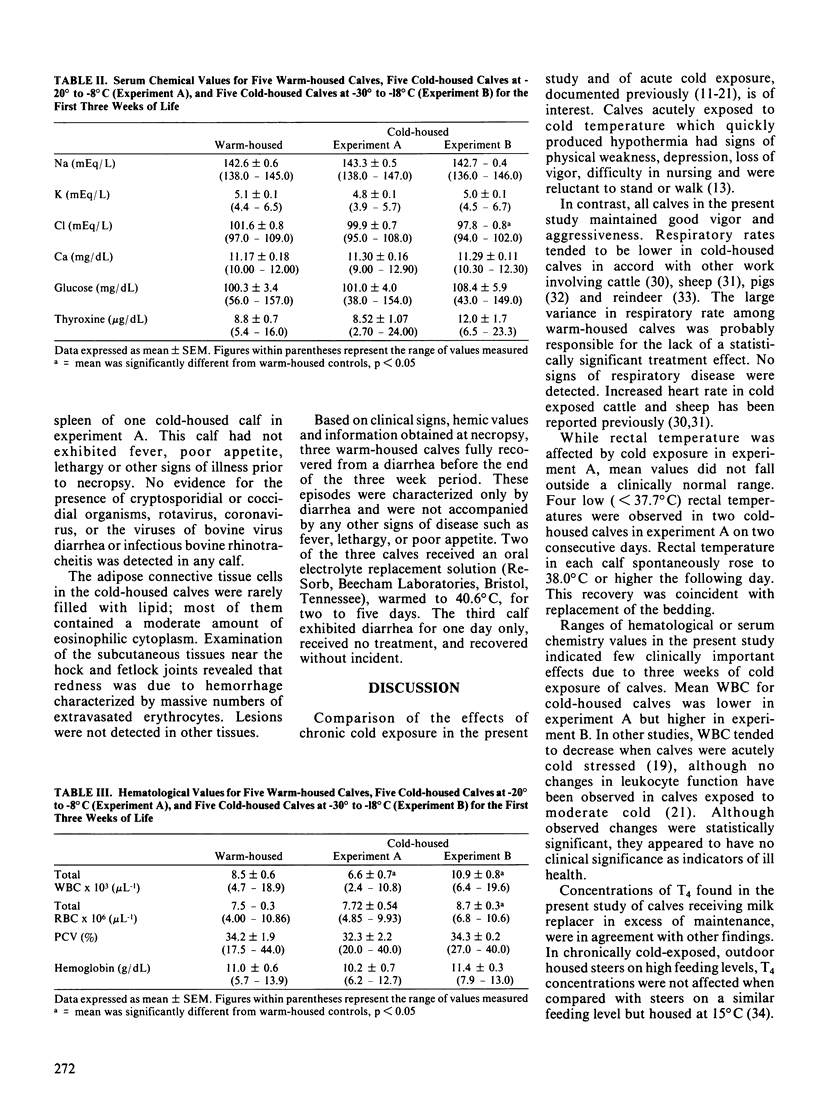

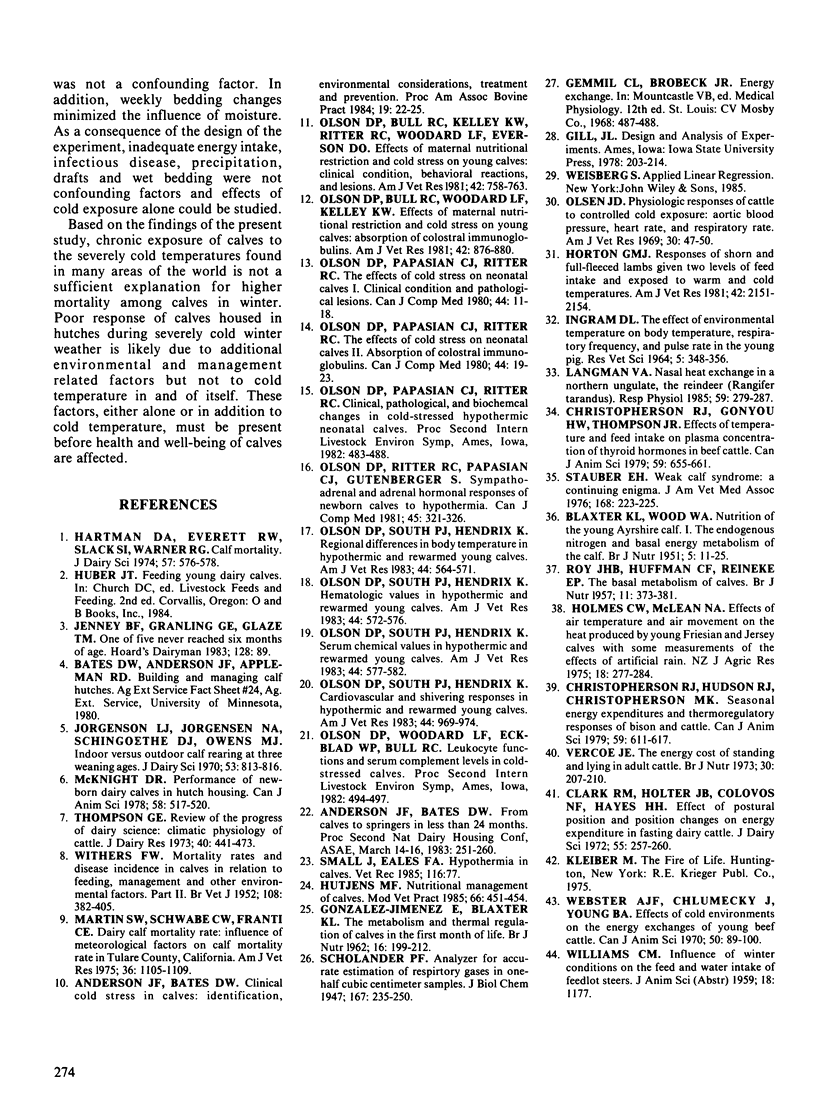
Images in this article
Selected References
These references are in PubMed. This may not be the complete list of references from this article.
- BLAXTER K. L., WOOD W. A. The nutrition of the young Ayrshire calf. I. The endogenous nitrogen and basal energy metabolism of the calf. Br J Nutr. 1951;5(1):11–25. doi: 10.1079/bjn19510004. [DOI] [PubMed] [Google Scholar]
- GONZALEZ-JIMENEZ E., BLAXTER K. L. The metabolism and thermal regulation of calves in the first month of life. Br J Nutr. 1962;16:199–212. doi: 10.1079/bjn19620021. [DOI] [PubMed] [Google Scholar]
- Horton G. M. Responses of shorn and full-fleeced lambs given two levels of feed intake and exposed to warm and cold temperatures. Am J Vet Res. 1981 Dec;42(12):2151–2154. [PubMed] [Google Scholar]
- Langman V. A. Nasal heat exchange in a northern ungulate, the reindeer (Rangifer tarandus). Respir Physiol. 1985 Mar;59(3):279–287. doi: 10.1016/0034-5687(85)90133-1. [DOI] [PubMed] [Google Scholar]
- Martin S. W., Schwabe C. W., Franti C. E. Dairy calf mortality rate: influence of meteorologic factors on calf mortality rate in Tulare County, California. Am J Vet Res. 1975 Aug;36(08):1105–1109. [PubMed] [Google Scholar]
- Olsen J. D. Physiologic response of cattle to controlled cold exposure: aortic blood pressure, heart rate, and respiratory rate. Am J Vet Res. 1969 Jan;30(1):47–50. [PubMed] [Google Scholar]
- Olson D. P., Bull R. C., Kelley K. W., Ritter R. C., Woodard L. F., Everson D. O. Effects of maternal nutritional restriction and cold stress on young calves: clinical condition, behavioral reactions, and lesions. Am J Vet Res. 1981 May;42(5):758–763. [PubMed] [Google Scholar]
- Olson D. P., Bull R. C., Woodard L. F., Kelley K. W. Effects of maternal nutritional restriction and cold stress on young calves: absorption of colostral immunoglobulins. Am J Vet Res. 1981 May;42(5):876–880. [PubMed] [Google Scholar]
- Olson D. P., Papasian C. J., Ritter R. C. The effects of cold stress on neonatal calves. I. Clinical condition and pathological lesions. Can J Comp Med. 1980 Jan;44(1):11–18. [PMC free article] [PubMed] [Google Scholar]
- Olson D. P., Papasian C. J., Ritter R. C. The effects of cold stress on neonatal calves. II. Absorption of colostral immunoglobulins. Can J Comp Med. 1980 Jan;44(1):19–23. [PMC free article] [PubMed] [Google Scholar]
- Olson D. P., Ritter R. C., Papasian C. J., Gutenberger S. Sympathoadrenal and adrenal hormonal responses of newborn calves to hypothermia. Can J Comp Med. 1981 Jul;45(3):321–326. [PMC free article] [PubMed] [Google Scholar]
- Olson D. P., South P. J., Hendrix K. Cardiovascular and shivering responses in hypothermic and rewarmed young calves. Am J Vet Res. 1983 Jun;44(6):969–974. [PubMed] [Google Scholar]
- Olson D. P., South P. J., Hendrix K. Hematologic values in hypothermic and rewarmed young calves. Am J Vet Res. 1983 Apr;44(4):572–576. [PubMed] [Google Scholar]
- Olson D. P., South P. J., Hendrix K. Regional differences in body temperature in hypothermic and rewarmed young calves. Am J Vet Res. 1983 Apr;44(4):564–571. [PubMed] [Google Scholar]
- Olson D. P., South P. J., Hendrix K. Serum chemical values in hypothermic and rewarmed young calves. Am J Vet Res. 1983 Apr;44(4):577–582. [PubMed] [Google Scholar]
- ROY J. H., HUFFMAN C. F., REINEKE E. P. The basal metabolism of the newborn calf. Br J Nutr. 1957;11(4):373–381. doi: 10.1079/bjn19570058. [DOI] [PubMed] [Google Scholar]
- Small J., Eales F. A. Hypothermia in calves. Vet Rec. 1985 Jan 19;116(3):77–77. doi: 10.1136/vr.116.3.77. [DOI] [PubMed] [Google Scholar]
- Stauber E. H. Weak calf syndrome: a continuing enigma. J Am Vet Med Assoc. 1976 Feb 1;168(3):223–225. [PubMed] [Google Scholar]
- Vercoe J. E. The energy cost of standing and lying in adult cattle. Br J Nutr. 1973 Sep;30(2):207–210. doi: 10.1079/bjn19730026. [DOI] [PubMed] [Google Scholar]



